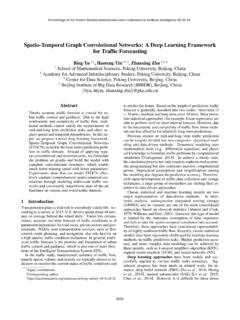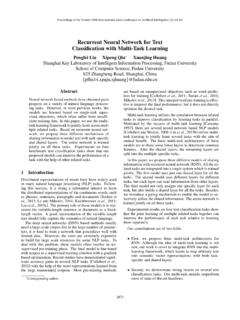Transcription of An introduction to neural networks for beginners
1 an introduction to neural networks for beginners By Dr Andy Thomas Adventures in Machine Learning Table of Contents 2. Who I am and my approach .. 2. The code, pre-requisites and installation .. 3. Part 1 introduction to neural networks .. 3. What are artificial neural networks ? .. 3. The structure of an ANN .. 4. The artificial neuron .. 4. Nodes .. 5. The bias .. 6. Putting together the structure .. 8. The notation .. 9. The feed-forward pass .. 10. A feed-forward example ..11. Our first attempt at a feed-forward A more efficient implementation .. 13. Vectorisation in neural networks .. 13. Matrix 14. Gradient descent and optimisation .. 16. A simple example in code .. 18. The cost function .. 19. Gradient descent in neural networks .. 20. A two dimensional gradient descent example .. 20. Backpropagation in depth .. 21. Propagating into the hidden layers.
2 24. Vectorisation of 26. Implementing the gradient descent step .. 27. The final gradient descent algorithm .. 28. Implementing the neural network in Python .. 29. Scaling data .. 30. PAGE 1. Creating test and training datasets .. 31. Setting up the output layer .. 32. Creating the neural network .. 32. Assessing the accuracy of the trained model .. 38. introduction Welcome to the an introduction to neural networks for beginners book. The aim of this much larger book is to get you up to speed with all you need to start on the deep learning journey using TensorFlow. Once you're finished, you may like to check out my follow-up book entitled Coding the Deep Learning Revolution A step by step introduction using Python, Keras and TensorFlow. What is deep learning, and what is TensorFlow? Deep learning is the field of machine learning that is making many state-of-the-art advancements, from beating players at Go and Poker, to speeding up drug discovery and assisting self-driving cars.
3 If these types of cutting edge applications excite you like they excite me, then you will be interesting in learning as much as you can about deep learning. However, that requires you to know quite a bit about how neural networks work. This will be what this book covers getting you up to speed on the basic concepts of neural networks and how to create them in Python. WHO I AM AND MY APPROACH. I am an engineer who works in the energy / utility business who uses machine learning almost daily to excel in my duties. I believe that knowledge of machine learning, and its associated concepts, gives you a significant edge in many different industries, and allows you to approach a multitude of problems in novel and interesting ways. I also maintain an avid interest in machine and deep learning in my spare time, and wish to leverage my previous experience as a university lecturer and academic to educate others in the coming AI and machine learning revolution.
4 My main base for doing this is my website . Adventures in Machine Learning. Some educators in this area tend to focus solely on the code, with neglect of the theory. Others focus more on the theory, with neglect of the code. There are problems with both these types of approaches. The first leads to a stunted understanding of what one is doing you get quite good at implementing frameworks but when something goes awry or not quite to plan, you have no idea how to fix it. The second often leads to people getting swamped in theory and mathematics and losing interest before implementing anything in code. PAGE 2. My approach is to try to walk a middle path with some focus on theory but only as much as is necessary before trying it out in code. I also take things slowly, in a step-by-step fashion as much as possible. I get frustrated when educators take multiple steps at once and perform large leaps in logic, which makes things difficult to follow, so I assume my readers are likewise annoyed at such leaps and therefore I try not to assume too much.
5 THE CODE, PRE-REQUISITES AND INSTALLATION. This book will feature snippets of code as we go through the explanations, however the full set of code can be found for download at my github repository. This book does require some loose pre-requisites of the reader these are as follows: - A basic understanding of Python variables, arrays, functions, loops and control statements - A basic understanding of the numpy library, and multi-dimensional indexing - Basic matrix multiplication concepts and differentiation While I list these points as pre-requisites, I expect that you will still be able to follow along reasonably well if you are lacking in some of these areas. I expect you'll be able to pick up these ideas as you go along I'll provide links and go slowly to ensure that is the case. To install the required software, consult the following links: - Python (this version is required for TensorFlow): - Numpy: - Sci-kit learn: It may be easier for you to install Anaconda, which comes with most of these packages ready to go and allows easy installation of virtual environments.
6 Part 1 introduction to neural networks WHAT ARE ARTIFICIAL neural networks ? Artificial neural networks (ANNs) are software implementations of the neuronal structure of our brains. We don't need to talk about the complex biology of our brain structures, but suffice to say, the brain contains neurons which are kind of like organic switches. These can change their output state depending on the strength of their electrical or chemical input. The neural network in a person's brain is a hugely interconnected network of neurons, where the output of any given neuron may be the input to thousands of other neurons. Learning occurs by repeatedly activating certain neural connections over others, and this reinforces those connections. This makes them more likely to produce a desired outcome given a specified input. This PAGE 3. learning involves feedback when the desired outcome occurs, the neural connections causing that outcome becomes strengthened.
7 Artificial neural networks attempt to simplify and mimic this brain behavior. They can be trained in a supervised or unsupervised manner. In a supervised ANN, the network is trained by providing matched input and output data samples, with the intention of getting the ANN to provide a desired output for a given input. An example is an e-mail spam filter the input training data could be the count of various words in the body of the e- mail, and the output training data would be a classification of whether the e-mail was truly spam or not. If many examples of e-mails are passed through the neural network this allows the network to learn what input data makes it likely that an e-mail is spam or not. This learning takes place be adjusting the weights of the ANN connections, but this will be discussed further in the next section. Unsupervised learning in an ANN is an attempt to get the ANN to understand the structure of the provided input data on its own.
8 This type of ANN will not be discussed in this book. THE STRUCTURE OF AN ANN. The artificial neuron The biological neuron is simulated in an ANN by an activation function. In classification tasks ( identifying spam e-mails) this activation function must have a switch on . characteristic in other words, once the input is greater than a certain value, the output should change state from 0 to 1, from -1 to 1 or from 0 to >0. This simulates the turning on of a biological neuron. A common activation function that is used is the sigmoid function: 1. ( ) =. 1 + ( ). Which looks like this: PAGE 4. Figure 1 The sigmoid function As can be seen in the figure above, the function is activated it moves from 0 to 1. when the input x is greater than a certain value. The sigmoid function isn't a step function however, the edge is soft , and the output doesn't change instantaneously.
9 This means that there is a derivative of the function and this is important for the training algorithm which is discussed more in Section Backpropagation in depth. Nodes As mentioned previously, biological neurons are connected hierarchical networks , with the outputs of some neurons being the inputs to others. We can represent these networks as connected layers of nodes. Each node takes multiple weighted inputs, applies the activation function to the summation of these inputs, and in doing so generates an output. I'll break this down further, but to help things along, consider the diagram below: Figure 2 Node with inputs The circle in the image above represents the node. The node is the seat of the activation function, and takes the weighted inputs, sums them, then inputs them to the activation function. The output of the activation function is shown as h in the above diagram.
10 Note: a node as I have shown above is also called a perceptron in some literature. What about this weight idea that has been mentioned? The weights are real valued numbers ( not binary 1s or 0s), which are multiplied by the inputs and then summed up in the node. So, in other words, the weighted input to the node above would be: PAGE 5. 1 1 + 2 2 + 3 3 + . Here the values are weights (ignore the b for the moment). What are these weights all about? Well, they are the variables that are changed during the learning process, and, along with the input, determine the output of the node. The b is the weight of the +1 bias element the inclusion of this bias enhances the flexibility of the node, which is best demonstrated in an example. The bias Let's take an extremely simple node, with only one input and one output: Figure 3 Simple node The input to the activation function of the node in this case is simply 1 does changing 1do in this simple network ?




![arXiv:1910.03151v4 [cs.CV] 7 Apr 2020](/cache/preview/f/4/1/e/d/d/8/f/thumb-f41edd8febe3e5c0bf37eae38812e8b7.jpg)



